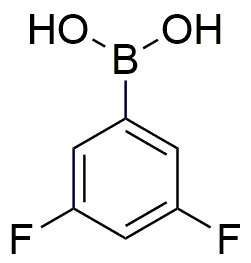3,5-Difluorophenylboronic acid is widely utilized in research focused on:
- Pharmaceutical Development: This compound plays a crucial role in synthesizing various pharmaceuticals, particularly in the development of drugs targeting cancer and other diseases. Its unique properties allow for the creation of more effective therapeutic agents.
- Organic Synthesis: It serves as a versatile building block in organic chemistry, facilitating the formation of complex molecules. Researchers leverage its boronic acid functionality for coupling reactions, enhancing the efficiency of synthetic pathways.
- Materials Science: The compound is used in creating advanced materials, including polymers and nanomaterials. Its ability to form stable bonds makes it valuable in developing materials with specific properties for electronics and coatings.
- Bioconjugation: In biochemistry, it is utilized for attaching biomolecules to surfaces or other molecules, aiding in the development of biosensors and drug delivery systems. This application is vital for improving the efficacy of therapeutic interventions.
- Fluorescent Probes: The compound can be incorporated into fluorescent probes for imaging applications in biological research. This allows scientists to visualize cellular processes in real-time, providing insights into disease mechanisms.
General Information
Properties
Safety and Regulations
Applications
3,5-Difluorophenylboronic acid is widely utilized in research focused on:
- Pharmaceutical Development: This compound plays a crucial role in synthesizing various pharmaceuticals, particularly in the development of drugs targeting cancer and other diseases. Its unique properties allow for the creation of more effective therapeutic agents.
- Organic Synthesis: It serves as a versatile building block in organic chemistry, facilitating the formation of complex molecules. Researchers leverage its boronic acid functionality for coupling reactions, enhancing the efficiency of synthetic pathways.
- Materials Science: The compound is used in creating advanced materials, including polymers and nanomaterials. Its ability to form stable bonds makes it valuable in developing materials with specific properties for electronics and coatings.
- Bioconjugation: In biochemistry, it is utilized for attaching biomolecules to surfaces or other molecules, aiding in the development of biosensors and drug delivery systems. This application is vital for improving the efficacy of therapeutic interventions.
- Fluorescent Probes: The compound can be incorporated into fluorescent probes for imaging applications in biological research. This allows scientists to visualize cellular processes in real-time, providing insights into disease mechanisms.
Documents
Safety Data Sheets (SDS)
The SDS provides comprehensive safety information on handling, storage, and disposal of the product.
Product Specification (PS)
The PS provides a comprehensive breakdown of the product’s properties, including chemical composition, physical state, purity, and storage requirements. It also details acceptable quality ranges and the product's intended applications.
Certificates of Analysis (COA)
Search for Certificates of Analysis (COA) by entering the products Lot Number. Lot and Batch Numbers can be found on a product’s label following the words ‘Lot’ or ‘Batch’.
*Catalog Number
*Lot Number
Certificates Of Origin (COO)
This COO confirms the country where the product was manufactured, and also details the materials and components used in it and whether it is derived from natural, synthetic, or other specific sources. This certificate may be required for customs, trade, and regulatory compliance.
*Catalog Number
*Lot Number
Safety Data Sheets (SDS)
The SDS provides comprehensive safety information on handling, storage, and disposal of the product.
DownloadProduct Specification (PS)
The PS provides a comprehensive breakdown of the product’s properties, including chemical composition, physical state, purity, and storage requirements. It also details acceptable quality ranges and the product's intended applications.
DownloadCertificates of Analysis (COA)
Search for Certificates of Analysis (COA) by entering the products Lot Number. Lot and Batch Numbers can be found on a product’s label following the words ‘Lot’ or ‘Batch’.
*Catalog Number
*Lot Number
Certificates Of Origin (COO)
This COO confirms the country where the product was manufactured, and also details the materials and components used in it and whether it is derived from natural, synthetic, or other specific sources. This certificate may be required for customs, trade, and regulatory compliance.


